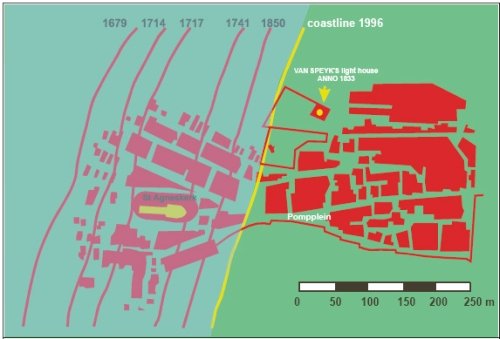
Holland - the coastline
- Details
- Category: Geography

The Dutch coast consists of sandy, multi-barred beaches and can be characterised as a wave-dominated coast. Approximately 290 km of the coast consists of dunes and 60 km is protected by structures such as dikes and dams. With the melting of the ice at the end of the last ice age the coastline shifted eastward until about 5000 years ago the present position of the Dutch coastline was reached.
As the sea level rise stagnated, the sand supply decreased and the formation of the beach ridges stopped, after which when the sea broke through the lines of dunes during storms, men started to defend the land by building primitive dikes and walls. The dunes, together with the beach and the shoreline, offer a natural, sandy defence to the sea. About 30% of the Netherlands lies below sea level.
Holland coast recession
Over the last 30 years, approximately 1 million m³ sand per year has been lost from the Dutch coast to deep water. In most northern coastal sections, erosion occurs in deep water and also in the nearshore zone. In most southern sections, sedimentation occurs in the nearshore zone and erosion in deep water.
Structural erosion is due to sea level rise relative to the land and, in some spots, it is caused by harbour dams. The Dutch coast looked at as a single unit shows erosive behaviour. Approximately 12 million m³ of sand is transferred annually from the North Sea to the Wadden Sea as a result of relative rising sea level and coastal erosion.
Latest articles
- Accommodatie Eurovisie Songfestival 2020 - Rotterdam
- Vermeer - famous Dutch painter from Delft
- Delft - Oude Kerk - Old Church
- Delft
- Enkhuizen - Havenweg - streetview - Google Maps
- Alkmaar - cheese market - Waagplein - streetview - Google Maps
- Hoorn - city center - Roode Steen - streetview - Google Maps
- Veere - Townhall - streetview - Google Maps
- Middelburg - Townhall - streetview - Google Maps
- Vlissingen - Smallekade - streetview - Google Maps
- Zierikzee- streetview - Google Maps
- Oosterschelde- streetview - Google Maps
- Haringvlietdam - Haringvlietsluis - streetview - Google Maps
- Hollands Diep - streetview - Google Maps
- Moerdijk bridges - streetview - Google Maps
- Harlingen - streetview - Google Maps
- Stavoren - streetview
- Dokkum - streetview
- Giethoorn - streetview
- Claire Morgan The Sound of Silence - Noord Brabants Museum
Visitors for Visitholland
We have 215 guests and no members online

